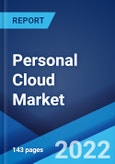Personal cloud, or mobile cloud, refers to a local network-attached storage (NAS) cloud facility used for storing and sharing personal or professional data, such as videos, photos and documents. It is an assembly of digitally stored services and information that can be accessed remotely and is commonly used by individuals, small businesses and organizations. It is used to synchronize or share sensitive data with various devices, such as tablets, personal computers and smartphones. It involves online and server device cloud storage facilities. They eliminate the need to store information on a hardware device and offer enhanced storage space, cost-effectiveness and accessibility to the consumer.
Personal Cloud Market Trends:
Significant growth in the information technology (IT) industry across the globe, along with rapid digitization, is among the key factors driving the market growth. Moreover, the increasing adoption of cloud-based data recovery systems is providing a thrust to the market growth. With the proliferating social media platforms, there is a growing requirement for personal storage systems for storing data that can be accessed through multiple devices. In line with this, the emergence of bring-your-own-devices (BYOD) and work from home (WFH) trends are also contributing to the growth of the market. Organizations use personal cloud storage systems to promote file storage and sharing among employees and businesses.Additionally, various technological advancements and the widespread adoption of Cloud as a Service (CaaS) business models are acting as other growth-inducing factors. These innovations offer individuals and organizations with enhanced flexibility, productivity and reduced infrastructural costs. Other factors, including extensive research and development (R&D) activities, along with increasing internet penetration, especially in the developing economies, are anticipated to drive the market toward growth.
Key Market Segmentation:
The publisher provides an analysis of the key trends in each sub-segment of the global personal cloud market report, along with forecasts at the global, regional and country level from 2024-2032. Our report has categorized the market based on revenue type, hosting type and end user.Breakup by Revenue Type:
- Direct
- Indirect
Breakup by Hosting Type:
- Service Providers
- Consumers
Breakup by End User:
- Individuals
- Enterprises
Breakup by Region:
- North America
- United States
- Canada
- Asia-Pacific
- China
- Japan
- India
- South Korea
- Australia
- Indonesia
- Others
- Europe
- Germany
- France
- United Kingdom
- Italy
- Spain
- Russia
- Others
- Latin America
- Brazil
- Mexico
- Others
- Middle East and Africa
Competitive Landscape:
The competitive landscape of the industry has also been examined along with the profiles of the key players being Amazon Web Services Inc. (Amazon.com Inc), Apple Inc., Barracuda Networks Inc, Box Inc., Buffalo Americas Inc, Dropbox Inc., Egnyte Inc., Google LLC (Alphabet Inc), Microsoft Corporation and SpiderOak Inc.Key Questions Answered in This Report
1. What was the size of the global personal cloud market in 2023?2. What is the expected growth rate of the global personal cloud market during 2024-2032?
3. What has been the impact of COVID-19 on the global personal cloud market?
4. What are the key factors driving the global personal cloud market?
5. What is the breakup of the global personal cloud market based on the revenue type?
6. What is the breakup of the global personal cloud market based on the hosting type?
7. What is the breakup of the global personal cloud market based on the end user?
8. What are the key regions in the global personal cloud market?
9. Who are the key players/companies in the global personal cloud market?
Table of Contents
Companies Mentioned
- Amazon Web Services Inc. (Amazon.com Inc)
- Apple Inc.
- Barracuda Networks Inc
- Box Inc.
- Buffalo Americas Inc
- Dropbox Inc.
- Egnyte Inc.
- Google LLC (Alphabet Inc)
- Microsoft Corporation
- SpiderOak Inc.
Methodology

LOADING...
Table Information
| Report Attribute | Details |
|---|---|
| No. of Pages | 138 |
| Published | August 2024 |
| Forecast Period | 2023 - 2032 |
| Estimated Market Value ( USD | $ 28.6 Billion |
| Forecasted Market Value ( USD | $ 119.7 Billion |
| Compound Annual Growth Rate | 17.2% |
| Regions Covered | Global |
| No. of Companies Mentioned | 10 |









